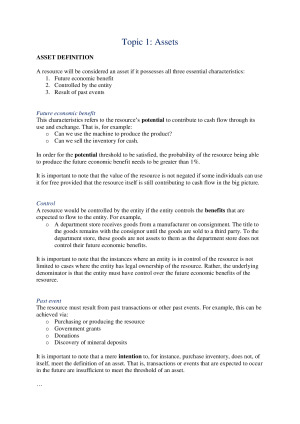HD 95 2020 ACCT1511 NOTES (FULL NOTES + ALL RELEVANT JOURNAL ENTRIES + FILL IN TEMPLATES)
Subject notes for UNSW ACCT1511
Description
An entire comprehensive set of notes for ACCT1511. For each topic, all the journal entries needed to complete your Quiz x2, Tutorial Participation, and Final are listed. For topics such as financial analysis and direct method cash flow statements, concise TEMPLATES have been provided. All you need to do is fill in the values from the Balance Sheet and Income Statement for your Quizzes and Final. A step by step process for topics like bonds calculations, cost vs revaluation models calculations, and overhead calculations have been provided. Achieved: 92 for Quiz 1, 100 for Quiz 2, 100 for Tutorial Participation, 95 for Final using these notes. Contains the following topics: - Asset definition - Asset recognition - capitalising vs expensing - current vs non-current assets - betterment vs repairs and maintenance - cost model - impairment - disposal of assets - revaluation model - development vs research - goodwill - intangible assets - amortisation and impairment of intangibles - liability definition - liability recognition - current vs non-current liabilities - borrowings - notes payable - bonds: normal, discount, premium - provisions vs contingent liabilities - warranty - components of shareholder's equity - private placement - general public issue: payable in full on application - general public issue: payable by instalment - cash trust, allotment and call - bonus issues - share splits - share buybacks - dividends declared and paid - revenue definition - revenue recognition - point of sale vs delivery - during production vs on completion of production method - expenses definition - expenses recognition - classification of expenses - common size statements - financial ratio analysis - profitability ratios (ROA, ROE, profit margin, gross margin, and so forth) - activity turnover ratios (asset turnover, inventory turnover, and so forth) - liquidity ratios (current ratio, quick ratio, and so forth) - financial structure ratios (debt-to-equity ratio, debt-to-assets ratios) - accounting policy choices - how to prepare cash flow statements - operating activities - investing activities - financing activities - indirect method - how to analyse the cash flow statement - cost classification - COGM - COGS - Raw materials, direct labour, overhead, variance, and so forth - Budgeting - sales budget, production budget, direct materials budget and so forth - behavioural aspects (lack of goal congruence, slack creation, myopia, resolutions). Happy studying!
UNSW
Term 3, 2020
60 pages
16,518 words
$54.00
2
Campus
UNSW, Kensington
Member since
September 2019
- LAWS1150 FINALS TEMPLATES (DISTINCTION) 2019
- TORTS HIGH DISTINCTION FINALS TEMPLATES 2019
- TORTS HIGH DISTINCTION MID-TERM TOPICS TEMPLATE 2019
- DISTINCTION FINALS INTENTIONAL TORTS TEMPLATES 2019
- HD 2020 PUBLIC LAW NOTES (NB: Marker feedback: one of the best responses for Midterm)
